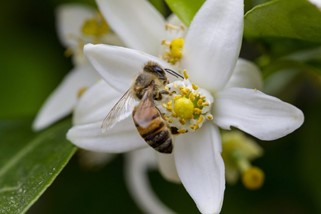Citrus Industry News
Protecting Honey Bees in Citrus Groves
By: Sylvia Willis, Amy Vu and Jamie Ellis
When people think of Florida, the first thing that comes to mind is Fresh From Florida oranges. Florida accounts for 44 percent of total U.S. citrus production.
Citrus, like many other fruits, vegetables and specialty crops, require certain inputs to grow and produce fruit. But how are pollinators and the production of citrus related? Many citrus varieties grown in Florida are self-pollinating hybrids and do not require assistance from pollinators, such as honey bees. However, groves provide the necessary resources for honey bee survival and beekeeper success.
Historically, there has been a working relationship between citrus growers and commercial beekeepers, where hives are placed in groves during bloom for honey bees to collect resources. Orange blossoms have an abundance of nectar that provides necessary carbohydrates that bees use for energy to conduct daily activities and to convert to “orange blossom” or “citrus” honeys. Without sources of carbohydrates, bees will starve and die.
Groves can be important locations during the winter months for beekeepers to produce new bee colonies and/or rejuvenate pre-existing colonies from Florida and across the United States. Because of the Florida climate, beekeepers move hundreds of thousands of honey bee colonies to/from Florida during their travels across the country.
CITRUS CHALLENGES
Over the past decade, the Florida citrus industry has changed drastically in response to the challenges associated to huanglongbing (HLB), also known as citrus greening. This disease is spread by the Asian citrus psyllid (ACP) and negatively affects citrus tree health.
Research has shown that management of HLB requires changes to production practices. One effective method available to control the ACP, thus slowing the spread of HLB, is pesticide application. In addition, growers are utilizing techniques to manage HLB properly to prevent pests. These techniques include scouting, monitoring and planting only certified disease-free nursery trees.
Though citrus growers do not directly manage honey bee hives, they are responsible for managing the grove with the health and safety of pollinators in mind. Honey bee colony loss can be attributed to many biological and environmental factors such as varroa(a parasitic mite that feeds on bee tissues), nutrition, genetics, foraging habitats, and in some cases, pesticide exposure. Since honey bees can be exposed to pesticides when leaving the hive to forage during citrus bloom, growers should take this into consideration when managing their groves.
PROTECTION PRACTICES
Careful considerations must be taken when insecticides are required for crop survival. For ACP control, there are several effective ingredients that are considered “bee safe” when applied during the bloom period that growers can include in their management plan. In 2020, an updated Florida Citrus Production Guide was produced that focused on pollinator protection and psyllid management. A common practice for growers is to apply pesticides prior to flower bloom, which reduces the need to apply during the bloom period when bees are foraging.
In addition, there are many methods of application that can also minimize the impact on honey bees. Examples of alternative applications include soil injection and foliar applications of selective insecticides.
Citrus growers should consider the risks and benefits associated with chemical controls when creating crop management plans to properly control pests and minimize honey bee and pollinator exposure. The product label should always be followed as the label is the law. Pesticide labels are developed in such a way to achieve maximum efficacy against the target pest while minimizing the product’s impact on non-target organisms.
In addition, citrus growers should develop a formal agreement with beekeepers that details responsibilities and liabilities that include items such as: contact information of each party, number and duration of hives on the property, hive location, list of pesticides intended to be applied while hives are on property, and more.
To access the complete article, go to:
https://citrusindustry.net/2021/03/22/protecting-honey-bees-in-citrus-groves/









